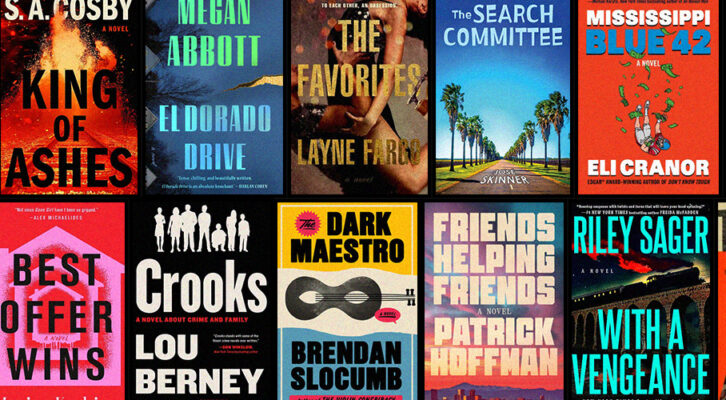“Human beings can lose their lives in libraries. They ought to be warned.”–Saul Bellow
Article continues after advertisement
1.
They found the body on Monday—in the field. It belonged to a woman, a mother, who is the same age as I am now.
In my memory’s eye, a child’s eye, the field is all brown—marsh scrub and grasses— and there is some shadow rimming the edges, trees of some kind. Oaks? Spruce? There’s no way to check now, as it all died out, was ripped out, when the townhouses went up. Whatever it was, it waves brown and tall in my child’s perspective as I climb out of our brown Plymouth Voyager into the parking lot of the local library.
“Woman’s body found behind library” is what the newspaper headlines proclaimed, but that was not exactly right, as the field was really in front of and alongside of the library, separated from it by the parking lot. Our library was on the right corner of a shopping plaza, one of only two near our little suburban development, anchored by a K-Mart and Basics grocery store. The library’s windows looked out into the busy shopping plaza, but the parking lot, the entrance, and the book drop were tucked just around the corner.
What I remember most is registering my mother’s tight face when I returned home from some place or another, and the droning of the helicopters. The helicopters were looking for the body, she told me. I had heard helicopters before, but they had all been of the traffic or life-flight variety. Now the droning meant not that a woman was out there, but her body was, somewhere in our small suburb that hadn’t seen a murder in more than two decades. It was afternoon, I’m certain, there was a peculiar too-bright September light, but the newspapers tell me my memory’s wrong—the helicopters didn’t come until early Monday morning, between 3:00 and 4:30 a.m. It rained, they called off the search, and then resumed it at noon, combing the 60-acre local park, until they realized the man they had in custody, when he said the body was in the park, meant this little untamed thatch across the parking lot from the library.
They found the body, then, on Monday, in the brown scrub in front of the library. Around its neck was the canvas strap from the tote the woman used to carry her library books.
2.
In all the books I read in that library, sitting cross-legged on the industrial blue-green carpet among the stacks, it was the same thing—characters encountered libraries full of forbidden knowledge, libraries that held secret books with secret spells, libraries with false bookcases that opened into hidden passageways.
The library was a magical, even a liminal space, and it was made for kids like me. I was a difficult kid who today would likely be labeled ADHD, who fidgeted, who talked nonstop, who had a hard time settling down. But I was capable of a laser-like focus when reading, and so I would read anything I could get my hands on to quiet my mind.
My mother packed us all up nearly every week, a free family outing for her three, then four, daughters. But while she took us to the library frequently, she was determined to control which books I got my hands on.
True, I was unduly influenced by what I read. Bridge to Terabithia, Where the Red Fern Grows, any books featuring death, led to crying fits and bouts of existential depression.
But this was also part of my mother’s larger campaign against contamination. We lived cloistered in our little suburb, The Triangle, they called it, bounded by highways, but set off from them behind a now-ornamental big iron gate, surrounded by woods. We attended Mass every Sunday, and my mother carefully monitored the food we ate, the programs we watched on TV, and the books we checked out of the library.
*
I was fifteen when the body was found.
That year, I had taken to stealing books. Or, not stealing exactly. Sneaking.
I would often check the books out, and then disappear in the stacks, to slide the Cosmopolitan magazine or makeover manual or volume of confessional poetry in my back waistband, its stiff outline disguised by my winter coat, to smuggle it home.
If it was a book that I feared the librarian might note as being too old for me (what do you need with Jaclyn Smith’s makeup tips? should you really be checking out The Joy of Sex, honey?) or might mention to my mother in passing when she later staggered up to the checkout counter under the weight of all my little sisters’ books (your oldest daughter is sure fond of those dark existentialists, isn’t she?), then I’d take the book without checking it out and return it weeks later to an odd spot of the library.
I’d ride home with the cool glossy cover sticking to my sweaty back, and once inside our house, duck into the bathroom to retrieve it, then slip it under my mattress to read by the glow of my nightlight.
3.
The very first library book I remember checking out, because I begged my parents ceaselessly for the privilege to do so, was the Nancy Drew series’ The Mysterious Mannequin. The cover featured a mannequin in traditional Turkish dress, only her blank black eyes visible underneath the white scarf that covers her hair, her forehead, her nose and mouth, her throat.
You can’t read that.
Yes, I can.
I remember it as a protracted battle. I must have been in second or third grade, and there were apparently many reasons why I shouldn’t check it out. It was beyond my reading abilities and here I was, jumping in at #47, instead of going in order. Why not start with #1, with The Secret of the Old Clock?
No. The Mysterious Mannequin. I loved the title, the slurry of the words I sung in my head over and over, mysterious mannequin, mysterious mannequin, the picture on the cover of a woman dressed in the most exotic clothing I had ever seen.
I was fifteen when the body was found. That year, I had taken to stealing books. Or, not stealing exactly. Sneaking.It was way beyond my reading abilities, but I struggled through, looking up the words I didn’t know in the dictionary or my paperback Roget’s Thesaurus, skimming entire pages to get the gist of things.
I hate to ruin the (terrible, very terrible) plot of The Mysterious Mannequin for you, but here’s the main twist: Nancy is searching for a mannequin that used to be in the storefront window of a rug shop. But what she thought was a lifeless dummy, a facsimile of a female body, turns out to be an actual flesh-and-blood woman.
The body found at our library operated in exactly the opposite way. She was a flesh-and-blood woman, thin and brunette and friendly and popular, reduced to a lifeless dummy. A thing that could be described as strangled or partially nude, a thing left discarded in a tiny field without much attempt made to hide it.
4.
When I outgrew Nancy Drew, I moved on to Agatha Christie. These detective stories were safe, approved by my frowning mother, unlike the Anne Sexton and Albert Camus and racy celebrity bios I snuck out of the library. And they were everything the hormonal storm of my own body was not— soothing, predictable, orderly, marching towards a tidy denouement, people reduced to certain types and with enough experience and logic you could simply figure out the ones to watch out for. How seductive that was! The boy who, one minute would be smiling and joking with you, calling you pretty, and the next would be trying to shove your head into his lap, or slap your face, or calling you an ugly slut, he could be anticipated and unmasked before he had the chance to do any damage, if one could just study the patterns enough.
One Agatha Christie novel, The Body in the Library, revolves around the discovery of the body of a pretty gold-digging dancer in the private library of a respectable old couple with no obvious connection to her.
This book is frequently used as an example of an inverted trope. In the 40s, when Christie’s book was written, detective fiction often featured a body found in a seemingly ordinary library. Yet that library would turn out to be far from ordinary. Perhaps it contained a bookcase that, if you could find the right lever, swung open into a secret passageway, or a trapdoor under a heavy oriental rug, or a secret panel that could be slid aside to spy on someone.
The library itself was the means of the murder. The murderer had slipped in and out through the passageway, the trapdoor, leveled the barrel of the shotgun through the opening of the secret panel. Mastering the library equaled solving the mystery.
In her murder mystery, Agatha Christie makes the library completely ordinary, simply shelves of books. It is the body that is out of the ordinary, the body that doesn’t belong, a brash blond interloper in a hushed space of dust motes and mildewing pages.
In my hometown, both the library and the body were completely ordinary. The library had a red brick front, it was attached to a shopping plaza, it had a children’s area in the center with giant cardboard picture books ringed by metal shelves overcrowded with tattered romance novels. It was populated by sticky kids and exhausted mothers who had given up dying their gray roots, by bespectacled shushing librarians and white-haired retirees. Another mom with her canvas library bag— this body fit right in.
Even the killer fit right in. The newspapers referred to him, over and over, as an outsider, as a drifter. An outside agent contaminating our cloistered Triangle. I was startled when court documents listed the killer’s address, and it was right up the road.
5.
After they found her body, my imagination would often settle on the last things she must have seen, the instant it dawned on her that she would die in front of the library. The memory that stuck in my 15-year-old mind, the one that is still there, was of facing the metal mouth of the return slot, and then turning into the light, that September too-bright morning light that comes in like a wave from under the skirts of the clouds, squinting in that light, and then a shadow cutting it off.
She had headed out around 10 that morning to the shopping plaza, parking her white Plymouth Sundance somewhere in its busy lot. She stopped by the ATM machine at 10:23 a.m. It was a Sunday morning, and the plaza would have been crowded with shoppers, although the library was closed. She was headed to the grocery store, but first ducked around the corner to return her library books.
She must have returned the books through the metal drop slot, as no police report or newspaper account mentions any books scattered out front, although they all mention the empty bag that he used to strangle her with. What were the books she had checked out, the last ones she would ever read?
6.
To write about this, to go back to the fall that I was 15, is more painful than I had expected it to be. To deal with the bodies. My body at 15 is strangely like that of my perimenopausal body now— a mess of scents and hair and pimples and too large breasts. Then, an inchoate rebellion, a hormonal storm left me locked in my room sobbing into my flowered comforter— everyone would be happier if I was dead. And the other body, in the field, partially nude, blanched, open-eyed overnight in the rain, no storm inside at all.
The library is where everything opened up. And the library is also where it all began to shut back down.
This is what I read about bodies in the library:
In Agatha Christie —across the old bearskin hearth rug there was sprawled something new and crude and melodramatic. The flamboyant figure of a girl… the scarlet of the lips looking like a gash.
In Henry Miller— the ugly gash, the wound that never heals. And also— A glance at that dark, unstitched wound and a deep fissure in my brain opens up.
In Anne Sexton—Fact: the body is dumb, the body is meat.
In Agatha Christie —Satin waistband of her own dress, which was passed round the neck and crossed at the back… There are no signs of a struggle.
In Nancy Drew—The face on the paper that stared up at her looked almost alive…“Wow!” Ned exclaimed when she showed [the sketch] to him. “A real doll! I mean mannequin!”
*
I registered but did not process these tidbits. I didn’t know what I knew. The sonnets designed to trap the prey—my mistress’s eyes, my mistress’s ass. The poem Byron wrote to celebrate the body of a 12-year-old girl.
The library is where everything opened up. And the library is also where it all began to shut back down.And the things that happened to the bodies of the women who wrote some of the books in the library: Percy pimped out Mary. Hughes punched Plath.
How hard is it to change a narrative that has already taken hold?
Who would I be if it were not for the library? But also, who would I be without the library? What might I have written without the bodies in the library, the constant ass-slap and catcall, or without wondering what was wrong with me to not even warrant harassing?
7.
He was found Sunday night, after he snatched another woman’s purse outside of a bar, with a .25 caliber semiautomatic and the white Plymouth Sundance that belonged to the woman who was now a body in the field outside the library.
He had been released just two days earlier on his own recognizance after being booked for breaking into a car and stealing a purse.
This matched his other priors— breaking and entering and purse-snatchings.
His first encounter with the law was five years earlier, when he was in his early twenties and over a two day period he broke into five different homes. He doesn’t seem to have been very experienced or very good at being a thief—he left behind a trail of evidence and was caught quickly, almost comically so.
And then, when he was in the County Detention Center, he broke a needle off in his arm, an injury that was recorded as a suicide attempt and required surgery.
After this surgery, while at the state mental hospital, he jumped out of a second story window to escape. He was caught the next day, but when he complained of injuries to his ankle from the jump and was taken to a hospital, he promptly escaped again. When he was caught more than a week later, he was evaluated by a prison doctor who said he had a drug and alcohol problem, and was also “antisocial, histrionic and narcissistic.”
He served 6 ½ years for his burglary rampage. He was released in June, five months early for good behavior, but required to see a parole officer, to whom he promptly confessed he had smoked marijuana, violating the terms of his release.
His attorney, in court, said that the morning he began his rampage he had smoked “several hundred dollars worth of cocaine” and went out looking for more money, that this rape and murder was a “purse snatching gone wrong.” His attorney claimed that, with a gun in his hand, a gun he had acquired in the two days since he had been released from prison, the man finally felt “power and authority.”
A gun. A body. Power and authority.
8.
Friends and neighbors interviewed for the local newspaper, summed up the woman who had once inhabited that body as “family-oriented, innocent, and quiet.” The stories told about her after her death were the sort of stories told about most middle-class female murder victims. How hard-working. The loss to the community. She was ours and some outsider spirited her away. Ie., She had worked her way up from secretary to supervisor. She kept a neat house, a well-manicured lawn. She had two sons and she held block parties and she worked on the Beautification Committee.
There was one comment by one long-time friend, admittedly probably taken out of context, but it still feels like an explanation. Like an accusation: She was “very timid—not so much a leader as a follower. That’s why she was so well-liked. Whatever you wanted to do was fine with her.”
Whatever you wanted to do. No mention of defensive wounds, of a struggle, of her fighting back. The story that circulated is one of her submitting, hoping it would be over soon, as soon as he got the things he wanted—her money, her car, her body.
*
I did not know the Nancy Drew I read about was purposefully made timid. Starting in 1959, the Stratemeyer Syndicate pushed for the first books in the series to be modernized— slurs, stereotypes, and dialect (thankfully) taken out; clothing and prices updated; and the plots condensed. In the older books first printed in the 1930s, Nancy is decidedly fierce. She carries her own gun, frequently drives her roadster well over the speed limit, and talks back to cops. She interrupts, she’s defiant, she demands. When she is grabbed by the bad guy, she twists and squirms, kicks and claws.
The revised Nancy Drew, the one in The Mysterious Mannequin, the first book I checked out of the library, is a more conciliatory version of herself. She smiles, she says things kindly, she adheres to the speed limit, she plays the peacemaker. When a burglar strikes, she is saved by her dog; when a bigger dog attacks her, she is saved by the housekeeper. She is jumped from behind and immediately knocked unconscious, then saved by her boyfriend. She never gets to fight back.
The memory that stuck in my 15-year-old mind, the one that is still there, was of the metal mouth of the return slot, and then the dazzling light, and then a shadow cutting it off. Hey, it’s okay. Let’s stay calm. You can have my money. My car. My body. And then she closed her eyes to that September too-bright morning light, hoping it would be quick.
9.
I hadn’t thought much about the library after that year, embroiled in my own adolescence, or at least I thought I hadn’t thought much about it. I assumed I started avoiding libraries for other reasons. The path to the library in college was where you might get yourself raped and killed. We were advised to always have an escort, to never walk alone.
When I would walk by myself, I would tell myself to make my mouth a muzzle. My hands large capacity magazines. My body as a gun was the only metaphor I could come up with. Power and authority.
*
At first it was cast as a crime of opportunity—she had a car, he had seen her getting cash out of the ATM, and then there was just this misunderstanding of the rape, things had gotten out of hand. What the “purse snatching gone wrong” argument assumes is that although he was in and out of prison he was not, up until he had a gun in his hand and encountered a woman at the library, known to be violent.
Except.
Except after his release from prison, he showed up at his sister’s house and tried to set it on fire, threatening to kill her.
Except the morning of the murder, he had broken into a woman’s house and instead of just taking her purse, raped her. It would take years for that crime to be attributed to him, even though it happened hours earlier, less than a mile away.
Except that he had a gun, but instead, the canvas strap of the library bag around her neck.
*
After the body was found, he was first charged with violating his parole in August, the month before the murder, not for threatening to kill a woman, but for smoking marijuana.
Newspaper accounts describe how he “appeared in court yesterday in his bare feet. He was heard telling members of his family that County Detention Center officials lost his shoes…right forearm was heavily bandaged, [he] appeared distraught and cried frequently.”
After he was charged with murder, he attempted suicide by swallowing razor blades from a plastic shaver.
What the “purse snatching gone wrong” argument assumes is that although he was in and out of prison he was not, up until he had a gun in his hand and encountered a woman at the library, known to be violent.At the sentencing hearing, the lawyer described his client as a “latent schizophrenic” and his childhood as one of sexual abuse, one of “absolute chaos and terror.” He took a plea deal after his lawyer argued that his client was HIV-positive and wouldn’t live long enough to make a death penalty case worth the state’s time.
I had to call the Department of Corrections to find out what became of him, as he couldn’t be found in any number of online databases.
“All I can tell you is he died.” The date she gives me is just six years after the murder.
I pressed the officer who took my call. Can you tell me where he died? How he died? What prison?
“He died in the hospital.” She paused. And then quickly, “But I really can’t tell you anything else.”
10.
The library is known as a feminized, cloistered space. A haven for geeky girls to find themselves, to curl up with a Nancy Drew. A third space, a safe space, outside of the home, outside of work, an escape. But where, exactly, did the library’s secret passageway take one?
I had bought into the narrative that libraries were transformative agents, extensions of my imagination. Maybe the library just represents the survival of knowledge, the transmission of it from one generation to the next.
I was surprised to find the story of the murder has been buried in a way the actual body was not. There was never any marker, or community self-defense classes, or cautionary school in-services.
My younger sisters spent much of their childhoods at the library too. One of them remembers hearing something about a murder from our mother, but always connected the crime to the ATM. Another connected it to the field. And the youngest never heard of it at all— there was no urban legend or scary story that survived among the younger set.
Maybe it was because, in a town that hadn’t seen a murder in twenty years, there suddenly were a lot more (a girl, in a botched robbery; a mother, by her enraged son; an infant, by the babysitter’s boyfriend). Or maybe we forgot because we didn’t know what to do with what we knew. The knowledge that there even is a body inside the library. That there is one, too, flung in the field out front.
Mastering the library equals solving the mystery.
In the first book I checked out of the library, Nancy tracks down the mysterious mannequin through her library card. The woman pretending to be a lifeless dummy had overdue books. Probably the lifeless dummy that was once a woman did too. That’s why I always assumed she was at the library that Sunday morning—trying to return the books before the library opened, to avoid an overdue fine.
When I go to drop my own overdue books in the return slot, I still hold my keys so that one is spiked out between my index and middle finger. I still look over my shoulder.
Mastering the library equals solving the mystery, and I haven’t yet managed either.
All I can do, all anyone can do, is look for the bodies, one by one.
















